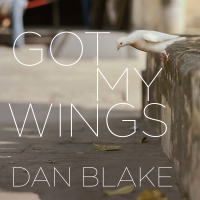Home » Jazz Musicians » Mitch Mitchell
Mitch Mitchell
As the drummer in the Jimi Hendrix Experience, Mitch Mitchell was one of the greatest and most influential rock drummers of the 1960s. Mitchell's style was a blend of the abandon of someone like Keith Moon, with the jazz complexity of an Elvin Jones or a Joe Morello. While no one, including Mitchell, could match Moon for sheer rock power, it's also true that Mitchell had the technique to handle some rhythms and patterns that were beyond Moon's abilities. Mitchell was drummer on all of the Hendrix Experience's recordings and some of his post-Experience solo outings, and was still in his touring band when Hendrix died in September 1970.
Mitchell was a former child actor who had starred in the BBC children's television series "Jennings" before he was even in his teens. By the early 1960s he was concentrating on his drumming, and gained experience in bands such as Pete Nelson and the Travellers and the Coronets. He also started doing some session work, and was a member of the Riot Squad, who had about a half-dozen soul-rock singles in the mid-1960s without getting a hit. He played on some of the Pretty Things' second album, Get the Picture. He was considered for the permanent drum seat in the band when Viv Prince left, but passed over in favor of Skip Alan, whom the Pretties felt to have a more suitable personality.
Mitchell played with Georgie Fame and the Blue Flames during 1965 and 1966, but was fired in October 1966 when the lineup disbanded. The day after the firing, Chas Chandler invited him to audition for the group being formed around Jimi Hendrix. Mitchell beat out a lot of top young talent in London, including the other finalist, Aynsley Dunbar. Chandler later said that, unable to make up their minds, he and Hendrix tossed a coin, the flip coming out, fortunately for everyone concerned (except Dunbar), in Mitchell's favor. Mitchell was not a mere sideman to Hendrix, but an important collaborator. Always changing rhythms, never predictable, he was also flexible enough to bounce off and respond to Hendrix's own original solo lines. This was evident on the very first singles and the trio's first album, Are You Experienced?, as can be heard on the thrilling drum parts on tracks like "Purple Haze", "Hey Joe", "Fire," "Foxy Lady","Third Stone from the Sun," "I Don't Live Today" and "Manic Depression." Axis: Bold As Love produced such great drum tracks as "Little Wing" "Castles Made of Sand", "Wait Until Tomorrow" and many more.
Read moreTags
Jimi Hendrix: Bold As Love ( 4CD + Blu-ray)

by Doug Collette
Recent history suggests the Jimi Hendrix estate would seem to be approaching the iconic guitarist's three original studio albums in reverse order. Electric Ladyland (Reprise, 1968) was issued in suitably extravagant form in 2018, fifty years after its original release. Now, Bold As Love (Reprise, 1967), simultaneously follows and predates the previous entry in the man's oeuvre, perhaps as means to suitably memorialize the 1967 debut in coming months. Four CDs (or five LPs) plus Blu-ray constitute a ...
Continue ReadingJimi Hendrix: Electric Lady Studios: A Jimi Hendrix Vision

by Doug Collette
Dyed-in-the-wool cynics, Jimi Hendrix fans or not, may well perceive Electric Lady Studios: A Jimi Hendrix Vision as a thinly-veiled means to camouflage the reality that the late guitar hero's vault may have been archived to its fullest possible extent. But the film at the heart of the collection acts as a prism of sorts, shedding so different a light on the multi-faced music of Hendrix music, the (over) familiarity of the content allows for new perspectives on the creative ...
Continue ReadingJimi Hendrix Experience: Live At The Hollywood Bowl – August 18, 1967

by Doug Collette
The archiving of Jimi Hendrix' vault has apparently reached the point where what happens on a given release is less important than when it happened. So it is with Live At The Hollywood Bowl--August 18, 1967, the setlist for which is similar to that of his ground-breaking June '67 performance at Monterey Pop, one the late rock icon would soon come to rue as he continued live appearances beyond a short stint in July '67 opening for the ...
Continue ReadingThe Jimi Hendrix Experience: Los Angeles Forum April 26, 1969

by Doug Collette
The Jimi Hendrix Experience's Los Angeles Forum April 26, 1969 is an integral component of one of the earliest posthumous Jimi Hendrix anthologies, the four x CD set Lifelines: The Jimi Hendrix Story (Reprise, 1990). Yet it appeared there in slightly truncated form, and until this standalone release, the entire concert has never been issued in its entirety. With various selections having been packaged in something of piecemeal fashion over the years, it is only now, in 2022, complete with ...
Continue ReadingJimi Hendrix Experience: Live In Maui

by Doug Collette
It's been quite the circuitous route from the second official posthumous Jimi Hendrix release Rainbow Bridge (Reprise, 1971) to Music, Money, Madness... Live In Maui. And while video component of the 2020 Jimi Hendrix archive release seems like much ado about nothing in its examination of the aforementioned film, the concert content of the Experience reminds how endlessly fascinating is/was the late guitar icon on stage. The audio portion of the package represents the first authorized release of ...
Continue ReadingMitch Mitchell: In Memoriam

by Gary Gomes
When the Jimi Hendrix Experience's Are You Experienced? initially appeared, all of the attention was focused on the guitarist--understandable, as this was his group, and the guitar sounds were unique extensions of blues, rock and electronics (the latter particularly) that had never made their way to the general record buying audience (greater displays of virtuosity could be heard from Danny Kalb and Larry Coryell a little earlier, and Clapton, Blackmore and Townshend had experimented successfully with feedback--albeit tentatively--a little earlier); ...
Continue ReadingJazz Musician of the Day: Mitch Mitchell

Source:
Michael Ricci
All About Jazz is celebrating Mitch Mitchell's birthday today!
JAZZ MUSICIAN OF THE DAY Mitch Mitchell
As the drummer in the Jimi Hendrix Experience, Mitch Mitchell was one of the greatest and most influential rock drummers of the 1960s. Mitchell\'s style was a blend of the abandon of someone like Keith Moon... more
Website | Videos | Articles
Follow Mitch Mitchell
Put AAJ's Musician of the Day box on your ...
read more
Hendrix Drummer Mitch Mitchell Dies

Source:
Michael Ricci
Mitch Mitchell, the drummer for the legendary Jimi Hendrix Experience of the 1960s, has been found dead in his Oregon hotel room. He was 61.
Erin Patrick, a deputy medical examiner in Multnomah County, said Mitchell was found dead shortly after 3 a.m. Wednesday in his room at the Benson Hotel in downtown Portland. She said Mitchell apparently died of natural causes. An autopsy is planned.
Hendrix, one of music's most celebrated guitarists, joined with Mitchell and bass player Noel ...
read more






















